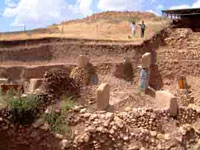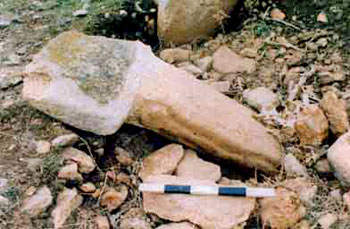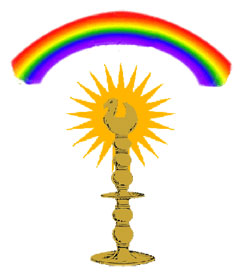i. Oldest Temple in the World
Covering an area the size of three tennis courts, the archaeological site known as Göbekli Tepe in South-east Turkey is known as the oldest temple in the world. Consisting of a series of sub-surface cult buildings, it is to be found on the top of a ridge overlooking a fertile agricultural landscape, north-east of the modern city of Saniurfa.
According to the German archaeologists who have been excavating here since 1995, Göbekli Tepe, as much as 11,500 years old, was constructed by faceless individuals (+/- 500 years) belonging to an epoch known as the Pre-Pottery Neolithic.
This was a transitional stage between the hunter gatherers of the still present Ice Age, and the more settled agricultural communities that emerged on the banks of the Euphrates river shortly after the ice sheets receded, causing a gradual change in temperature and environment.
Why exactly Göbekli Tepe was built even before this took place remains a mystery. All that makes sense is that the various linear structures with roofs supported by carved T-shaped pillars, displaying a wide range of animals, birds, serpents, spiders and anthropomorphs of a quality unequalled thereafter until the emergence of the Sumerian and Akkadian civilizations down in the fertile plains of Iraq thousands of years later. What was the purpose of these incredible prehistoric structures?
Might they be aligned to the stars like megalithic monuments worldwide?

Gobekli Tepe

Stone with serpent carving from Karahan Tepe ( photo: Harran University )
Nearby is another Pre-Pottery Neolithic site called Karahan Tepe, which dates to a similar age as Göbekli Tepe. Stone rows, T-shaped stone pillars, and other standing stones cover an area the size of a soccer field. One day it will, I believe, prove to be even more important than Göbekli Tepe.
Exactly what the mindset was behind those who created Early Neolithic sites such as Göbekli Tepe and Karahan Tepe is a complete mystery.
Who were these faceless individuals, and what inspired them to construct such incredible monuments at the end of the Last Ice Age?

Note similarity of the structure of the sperm to the carving on the stone above
Back to Contents
ii. The Direction of Heaven
The stone rows at Karahan Tepe are directed towards the north, and the temple structures at Göbekli Tepe are likewise roughly north-south.
Other stone structures in South-east Turkey from a slightly later age, such as Çayonu north of the city of Diyarbakir and the now submerged site of Nevali Çori in Hilvan province, between Diyabakir and Sanliurfa, also have their ritual areas at the northern ends. This preference for the north is found among the Sabians, a pagan race who thrived for thousands of years at the nearby city of Harran.
They envisaged the Primal Cause, God himself, as a divine force that resided in the north. This was their kiblah, or direction of prayer, while Sabian feasts honouring the Mystery of the North regularly took place.
Was it possible that the Sabian form of worship was a leftover from a much earlier epoch, when the earliest Neolithic temples were built in the same region?

Yezidi sanjak depicting cosmic bird atop the sky-pole.
Several other early cultures, religions and civilizations connected the north not only with the direction of the celestial abode, but also with the transmigration of the soul.
Among them were the Mandaeans of Iraq and Iran (first encountered by European travellers during the Middle Ages and erroneously termed 'St John's Christians'), the angel-worshipping Yezidi from Northern Iraq and Syria, and the Shiite sect known as the Brethren of Purity, all of which are descended from the Sabians of Harran.
Most usually it is the Pole Star, also known as the North Star, that is the object of their veneration, even though originally this could not have been Polaris, the current Pole Star, due to the process of precession.
Did the priestly elite of the Early Neolithic world also venerate the Pole Star during their own epoch, c. 9500-5500 BC? Like the Mandaeans, they practiced a cult of the dead, focused around the process of excarnation, whereby vultures were allowed to pick clean the flesh of human carcasses.
It is depicted on the walls of Çatal Huyuk, the oldest known city in the world, built on the Konya plain in Southern Turkey, c. 6500 BC, by the descendants of those responsible for sites such as Göbekli Tepe and Karahan Tepe in Southeast Turkey. At Çatal Huyuk we see the vulture carrying, or accompanying, the soul of the deceased, shown as a head, into the afterlife.
Once again, the north, along with the east, end of cult buildings that are associated with cosmic life and death. In addition to this, walls at Çatal Huyuk show scenes of shamans adopting the guise of the vulture to make otherworldly journeys. More evidence of the veneration of the vulture is to be found at the Early Neolithic sites of Southeast Turkey, including in one instance a bird emerging from a totem pole of human heads found at Nevali Çori and dated, c. 8000 BC.
Curiously, there was no Pole Star in 9500 BC. Indeed, one has to turn back the clocks to 11,000 BC in order to find one. This was Vega, the brightest star in Lyra, identified in the past as an eagle or vulture. It had held this role between 13,000-11,000 BC, before precession caused it to move too far away from the celestial pole to act as the North Star.
Had this been a celestial object of veneration among the Early Neolithic peoples of South-east Turkey, even after it ceased being Pole Star?
Although an attractive proposition it made no sense of alignments at the Neolithic sites examined, so another explanation was sought using a computer generated map of the night sky.
Back to Contents
iii. The Circle of Cygnus
Unable to determine whether the star Vega had been an object of veneration in the Early Neolithic world, we turn our attentions to Deneb, the brightest star in Cygnus, which until around 9300 BC was circumpolar (i.e. it never set) at the latitude of Göbekli Tepe and Karahan Tepe.
Moreover, on its lower transit of the meridian - the north-south zenith line that bisects the night sky - it crossed from left to right just above the northern horizon.
Cygnus was identified as a celestial bird on the Euphrates as early as c. 2000 BC.
Although most obviously a swan in Europe, Cygnus had, like Lyra, once been seen as a vulture, making it an obvious destination for those human souls being accompanied into the afterlife by a psychopomp (Greek for 'soul carrier') in the guise of the celestial vulture.
In pre-Islamic Arabic tradition, Cygnus was the Eagle of the Arabs, a mythical bird known also as the roc, or rukh. This was venerated by the Yezidi, the angel-worshipping descendants of the Sabians of Harran, as a form of Khuda (Kurdish for 'God '), associated with the Mysteries of the North.
The Yezidi depicted Khuda as a bird called anfar, which was seen perched on top of a pole used in private services and called a sanjak. Since the anfar is identified as a dove, it can be equated with the pigeon bird idols venerated prior to the age of Mohammed at Mecca, originally a Sabian shrine.
These idols have been identified variously with Allah and/or al-Lat, al-Uzza and Manat, three pre-Islamic goddesses associated with the swan, or crane. Their avian associations link them directly with Cygnus, which as the celestial swan came under the influence of Near Eastern love goddesses, who in Classical tradition were identified as Aphrodite and Venus.
In Christian tradition, Cygnus was seen as the Cross of Calvary as early as the sixth century, and arguably as far back as Roman times, where the crucifixion scene was associated more with the pagan god Orpheus, whom Jesus was portrayed as in a number of early Christian statues and murals found in Rome. In Classical tradition the swan of Cygnus was originally said to have been Orpheus, god of the underworld.
Cygnus was occasionally shown in Christian planispheres as Christ on the Cross, his wounds perhaps corresponding to its principal stars.
Moreover, the dove as a Christian symbol of the Holy Spirit (Greek pneuma), derives from the Hebrew concept of the Spirit or Breath of God (ruach), and stems from the same cosmological root as the Yezidi concept of the anfar, the form of Khuda (God ) as a bird that brought the universe into manifestation. In the first chapter of Genesis the Spirit of God (ruach) hovers over the primordial waters moments before God's Creation of the universe. The dove or pigeon was equated with Cygnus in Arabic tradition.
Cygnus can be found in the centre of the Milky Way, universally seen in past ages as a road or river of stars used by the dead, or the shaman in a state of trance. In ancient cosmology the Milky Way was equated with the World Tree, around which curled a serpent and on top was a celestial bird.
In shamanic tradition worldwide, this World Tree had to be ascended to reach the celestial abode, or sky-world, either via the Milky Way or the north-south meridian line. It was a realm accessed via a hole, door or gate at its most northerly point, and often this was seen as being located someone in the proximity of the cosmic axis, marked by the bird at the top of the tree, which we can safely identify as the Cygnus constellation.
This realization is expressed in the Mandaean concept of entry into the afterlife, which is gained via the Pole Star. Mandaean tradition speaks of no less than 360 melki, or divine beings. Among them is Abathur-Muzania (or Awather-Muzania), whose 'throne' is located 'behind the North star', known as the 'House of Abathur'. It is he,
"who judges the souls of men after they have passed through Purgatory, seeing whether they are purged enough to pass on into Paradise".
If deemed pure enough, the soul then makes its onward journey by boat over a celestial 'river', arguably the Milky Way, to one of the countless 'worlds of light', inhabited by their dead kinsmen. In these unimaginable realms, governed by 'great spirits of light', they meet other purified souls as well as their own 'dmutha or over-soul '.
It also makes sense of Karahan Tepe's secondary alignment towards sunrise on the summer solstice.
From here in 9500-9000 BC, the Milky Way emerged from the horizon and rose almost horizontally until it reached the stars of Cygnus which would have hung just above the northern horizon.
-
Did the Early Neolithic world associate Deneb and the stars of Cygnus with cosmic life and death, as their descendants, the Sabians, Mandaeans and Yezidi would seem to have done?
-
If correct, how did Deneb and the stars of Cygnus become so important to our earliest Neolithic ancestors?
The answer appears to lie in the fact that between c. 16,000-15,000 BC Deneb was Pole Star.
At the same time, the Milky Way would have risen up from the eastern horizon to where Cygnus occupied pole position, whilst the stars of Scorpio, anciently seen as a serpent, were placed at the base of the Milky Way expressed as the World Tree.
Did a veneration of Deneb and Cygnus linger over from the Late Palaeolithic era, c. 15,000 BC, through until Early Neolithic times, even after a dimmer star, delta Cygni (also in Cygnus), took over as Pole Star in c. 15,000 BC, retaining this role until 13,000 BC, when pole position was finally claimed by Vega?
The Early Neolithic sites in South-east Turkey as well as ancient cosmologies worldwide suggest that this was indeed the case. Yet how universal were these concepts, really? Only by tracing the roots of this apparently Palaeolithic ideology could the theory really be proved.
To achieve this aim, we turn our attentions to the ancient cosmology of the Native American peoples.
They, having arrived on the continent from Asia in Late Palaeolithic times and, in theory, having remained in isolation through until the time of the conquest, might well have preserved some semblance of knowledge regarding the former significance of Cygnus to the prehistoric mindset, imported on to the continent by nomadic peoples using the Bering land bridge between Siberia and Alaska, which emerged as the ice sheets withdrew at the end of the last Ice Age, c. 10,500-9500 BC.
Back to Contents
http://www.bibliotecapleyades.net/ciencia/ciencia_cygnus02.htm

